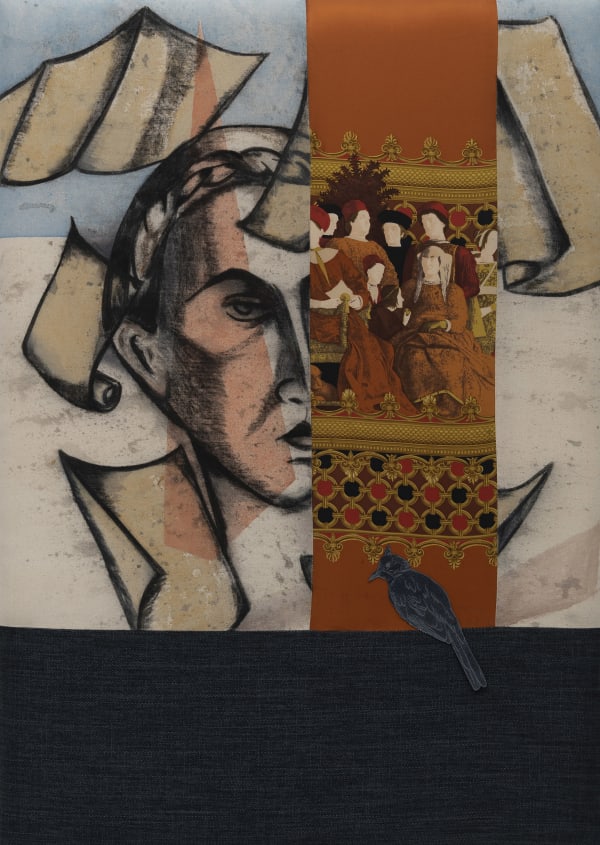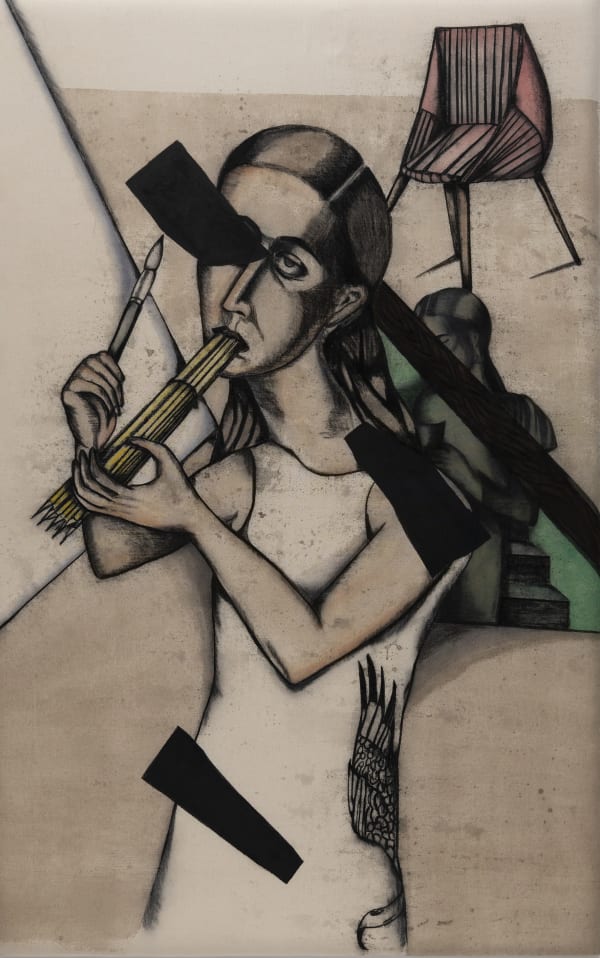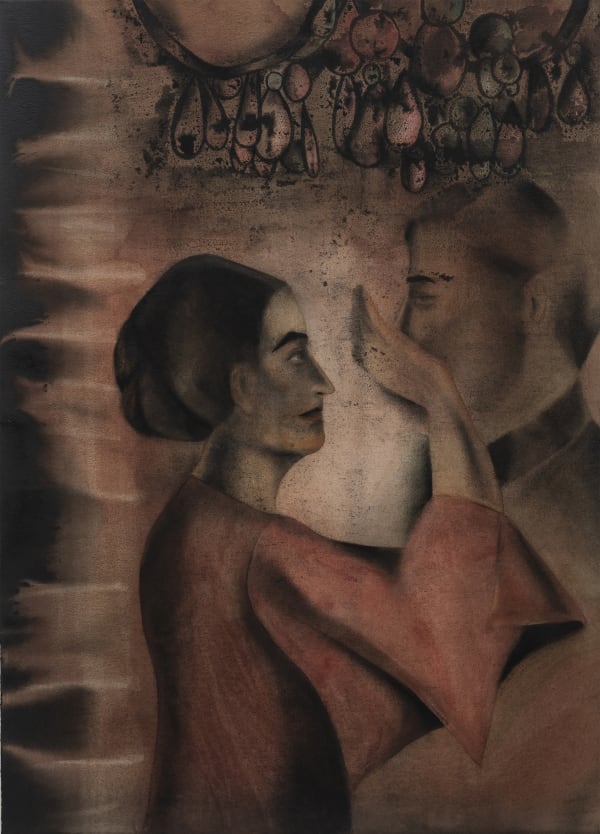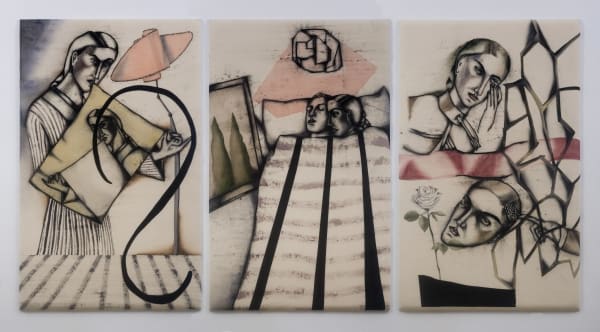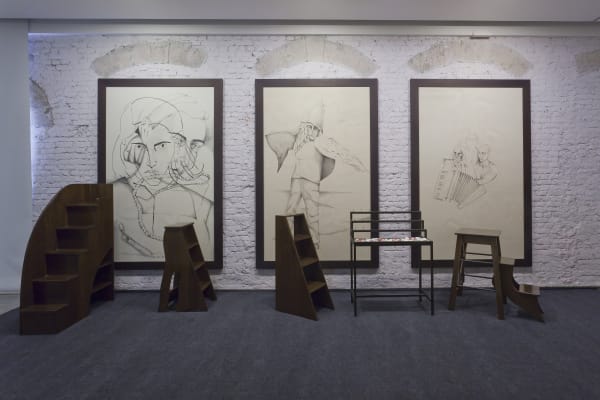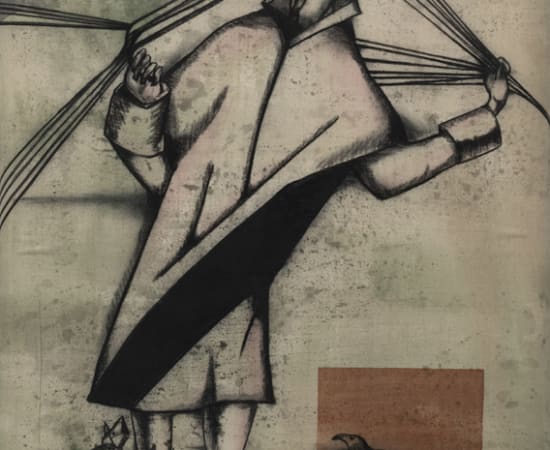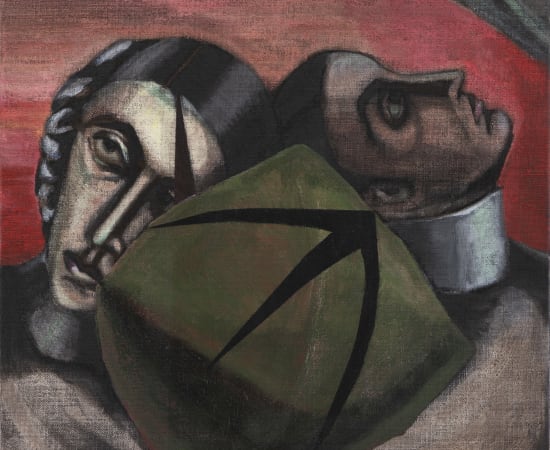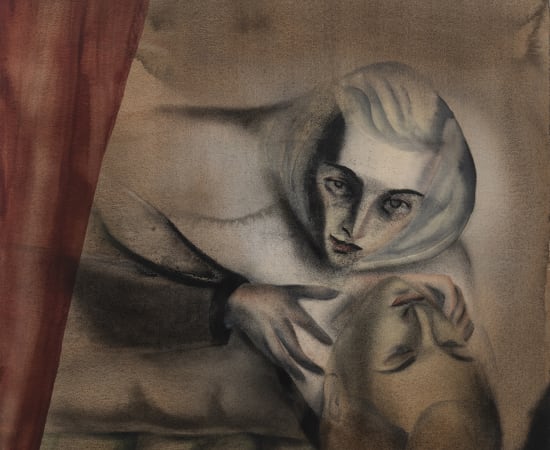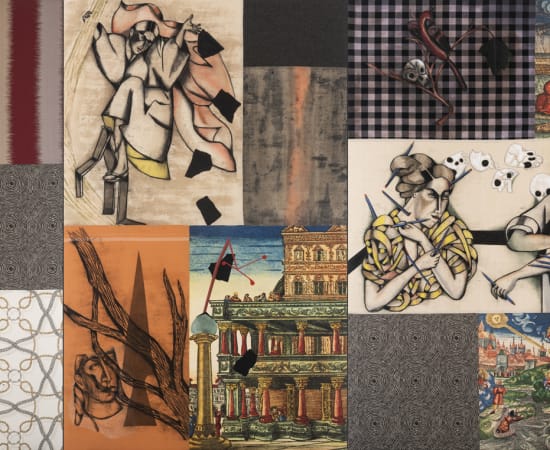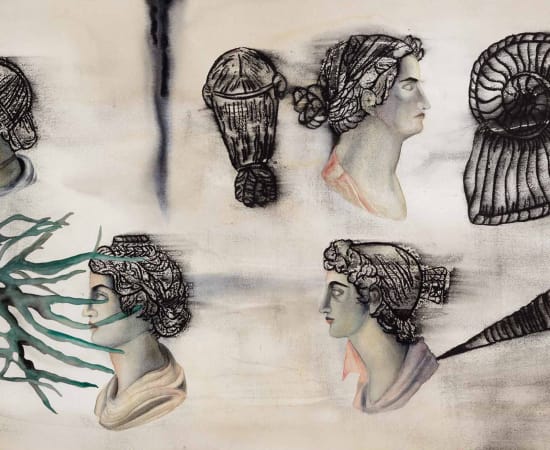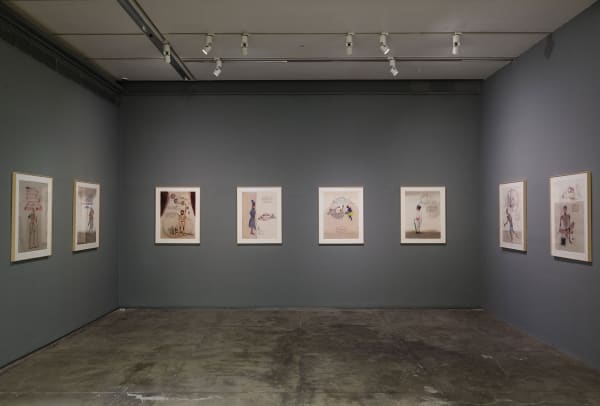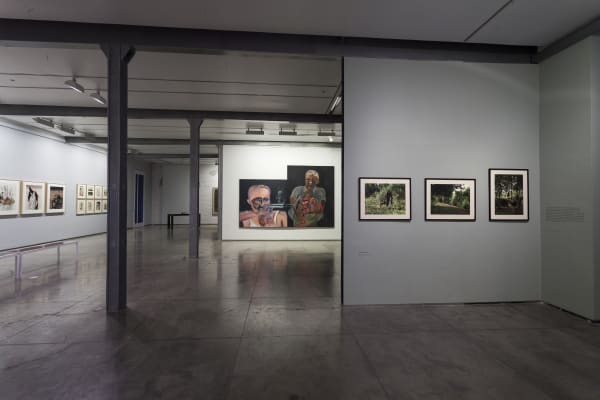Anju Dodiya b. 1964
-
 Girl In The Tree (after Giotto), 2020
Girl In The Tree (after Giotto), 2020 -
 Marching with mirrors, 2020
Marching with mirrors, 2020 -
 Ancestors, 2019
Ancestors, 2019 -
 Arachne's walk, 2019
Arachne's walk, 2019 -
 Heartbeat, 2019
Heartbeat, 2019 -
 Studio (with Phoenix), 2019
Studio (with Phoenix), 2019 -
 Supernatural, 2019
Supernatural, 2019 -
 Untitled (with chandelier), 2019
Untitled (with chandelier), 2019 -
 Flip | Room with a view | Honeycomb, 2018
Flip | Room with a view | Honeycomb, 2018 -
 Rehearsal for an Apocalypse, 2018
Rehearsal for an Apocalypse, 2018 -
 Runway of Wounds – II, 2015
Runway of Wounds – II, 2015 -
 Altar for Erasures, 2012
Altar for Erasures, 2012
b. 1964, in Mumbai, India
Mumbai-based artist, Anju Dodiya is renowned for her sensitive ‘fictional self-portraits’ that confront the terrifying act of creation. Dodiya graduated from the Sir JJ Schoolof Art in 1986, and since the 1990s has been recognised as among the most prominent artists of her generation. As a dedicated watercolourist, she pushes her medium to its limit on challenging surfaces in terms of scale and texture. Her works frequently juxtapose delicate and seemingly spontaneous watercolour smudges and stains against hard-lined charcoal incursions. Her first exhibition, a fictional autobiography (1991) at Gallery Chemould featured small-sized watercolour self-portraits of an artist/girl in a room, reckoning with creative anxiety. Over the decades, Dodiya has expanded her scale and visual vocabulary, carefully layering references from poetry, miniature paintings, Renaissance masters, Japanese Ukio-e prints, European cinema, and recently, Instagram. In her introspective works, viewers “encounter a palimpsest of art history, cinema, haute couture and private joke", cultural theorist Nancy Adajania has expressed.
Mythical women such as Daphne, Penelope, and Arachne have appeared in Dodiya’s paintings as protagonists embodying notions of vulnerability, or involved in the rhythm of labour. In paintings such as Circuit of the Gong (1998) Dodiya compares Athena’s birth from Jupiter’s head to the violent act of pulling ideas out of one’s mind.
In 2005, Dodiya was commissioned to depict the marriage of Shiva and Parvati, a large-scale work she realised on a double-bed installed upright on a wall. Mattresses and madarpat, the unbleached cotton that lines beds and sofas, are now recurrent materials in her practice. They serve as compelling surfaces for investigations of the private, domestic, and nocturnal. Dodiya has referred to them as ‘pregnant paintings'. Sculptural by default, such works became architectural devices in her iconic exhibition, The Throne of Frost (2007), an installation at the Durbar Hall of the Lakshmi Vilas Palace, Baroda. Here, Dodiya’s drawings could be viewed from a distance or as reflections on shards of mirrors on the floor, appearing in conversation with the ornate space. Ambiguous portraits of princesses holding pencil staves, a decadent Wajid Ali, and acrobats igniting continents, generated an elusive maze of emotion.
Her exhibition Room for Erasures (2012) at Chemould Prescott Road, invited viewers to erase portions of her large-scale drawings. Part memorial to the idea of vandalism in art, Dodiya relinquished control of her drawings to the viewer’s eraser. Her digital prints, Circuit for Erasures (2012) paired personal photographs with images of her artworks to meditate on memory and loss.
Dodiya investigates the act of remembrance through the fragility of the human body in a series of collages in The Book of Endings (2013) and in Death Robe (2013). She mentions filmmaker Ingmar Bergman and poet, Sylvia Plath as important sources of inspiration in her sometimes playful representations and explorations of the absurd. Dodiya contemplates the goriest of subjects with elegance - bare skulls, mythical beasts, and medieval torture devices. Saints, pilgrims, warriors, and poets become one person in her work. In paintings such as Paper Storm (2010) and Target and Studio (with Phoenix) (2019), we repeatedly see the artist’s paraphernalia —sharp pencils and eager paintbrushes serve as weapons. Pierce (2019), influenced by Ukiyo-e prints, depicts the artist as a samurai tackling the white of a canvas, in a theatrical gesture.
Dodiya’s narratives often feature curtains, costumes, and spotlights to negotiate the real and the imaginary. Rehearsal of an apocalypse (2018), a large-scale painting featured at the Kochi-Muziris Biennale (2018) confronts the possible end of the world with irony and an actor’s sense of distance. Scenes of terror alternate with the exposed vulnerable self.
Dodiya’s works ask viewers to unravel stories, without disclosing their full narratives. She pushes herself to be uninhibitedly immersed in the consuming act of making art.
-

Part 2 - Futuring | CheMoulding: Framing Future Archives
Curated by Shaleen Wadhwana | 60 Years of Gallery Chemould 15 Nov - 23 Dec 2023Futurists actively view the present world as a window to possible future outcomes. By this definition, we are all futurists. However, in reality, actively viewing the present means to confront...Read more -

Sharjah Biennial 15: Thinking Historically in the Present
7 Feb - 11 Jun 2023We are pleased to present the works of Anju Dodiya, Archana Hande, Lavanaya Mani, Mithu Sen, Nilima Sheikh, Reena Saini Kallat, Varunika Saraf and Vivan Sundaram at the Sharjah Biennial...Read more -

Modus Operandi III: Together Alone
Group Show 11 Aug - 10 Sep 2022The premise of Modus Operandi began and continues with an exhibition of Chemould's roster of artists - every iteration presents us an opportunity to exhibit them under one roof, in...Read more -

On|Site | Entry Only
Group show 3 - 9 Mar 2021A collaborative project between four galleries at Bikaner House, New Delhi. Bikaner House, a former residence of the Maharaja of Bikaner in Rajasthan, retains its grand aura of a distinguished...Read more -

Breathing on Mirrors
Anju Dodiya 11 Jun - 30 Jul 2020Venue : Chemould Prescott Road, Mumbai. Breathing on Mirrors ...as if, in a monosyllabic conversation, or mimicking emoticons, I have confined these drawings to a minimal emotional theatre. Like the...Read more -

Out-site / Insight
Group Show | In touch Edition I 24 Apr - 23 Jul 2020We approached our artists inquiring how they were doing in this time of isolation. Several of them are unable to make art - using their time to read, watch films,...Read more -

5 Artists, 5 Projects
Group show 10 Oct - 9 Nov 2019Generationally and presently, women artists have always dominated the spectrum of artists that we exhibit; this was not necessarily the decided route to take, however the trajectory presented itself. In...Read more -

Modus Operandi II
Group Show 18 Jul - 24 Aug 2019Synonymous with the first edition of Modus Operandi, where we brought together over 25 Chemould artists and their unique artistic language in dialogue with each other through various mediums, we...Read more -

Modus Operandi
Group Show 13 Jul - 18 Aug 2018This July, Chemould Prescott Road presents Modus Operandi , a show that has been devised by Shireen Gandhy and the Chemould team, brin ging together a large number of Chemould...Read more -

A Summer Mix
Group Show 20 May - 15 Jul 2015Aditi Singh | Anju Dodiya | Atul Dodiya | Bhuvanesh Gowda | Desmond Lazaro | Dhruvi Acharya | Gigi Scaria | Jitish Kallat | Lavanya Mani | Meera Devidayal |...Read more -

Aesthetic Bind: Subject of Death
50 Years of Chemould | Group Show 3 Sep - 3 Oct 2013Chemould Prescott Road, celebrates 50 years of Contemporary Art through a series of 5 exhibitions, Aesthetic Bind, curated by Geeta Kapur which looks at curatorial practices in contemporary art today....Read more -

Room for Erasures
Anju Dodiya 24 Sep - 26 Oct 2012Born in Bombay, Dodiya graduated from the JJ School of Art in 1986.In 1991, Dodiya had her first solo exhibition at Gallery Chemould; now she engages the larger space of...Read more -

crossing generations: diVERGE
40 Years of Chemould | Group Show 2 - 14 Dec 2003diVERGE is premised on the polyphony articulated by contemporary artists in India. Rather than zooming in to chart a convergent discourse, the exhibition pans over a diverse spectrum of subjectivities...Read more
-
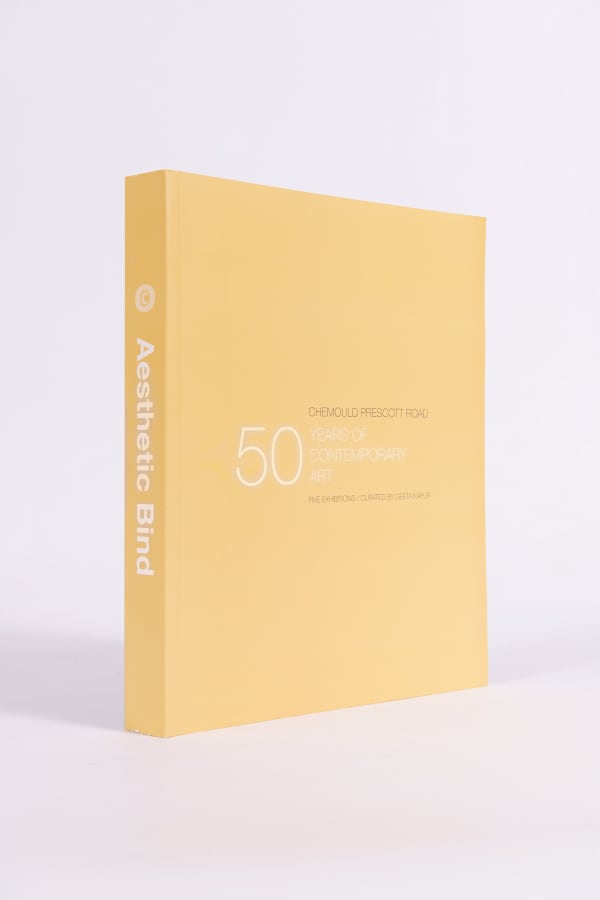
Aesthetic Bind
50 Years of Contemporary Art 2013 - 14SoftcoverRead more
Dimensions: 24 x 29 cm -

Bhupen Among Friends
Bhupen Khakhar 2005Softcover, 53 pagesRead more
Dimensions: 28 x 28cm -
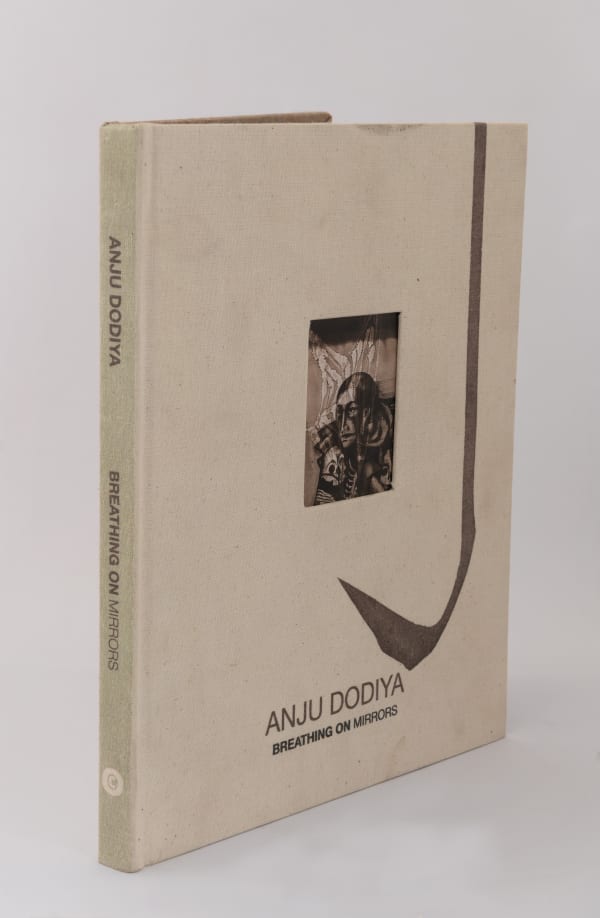
Breathing On Mirrors
Anju Dodiya 2021Hardcover, 90 pagesRead more
ISBN: 978-81-954610-1-1
Dimensions: 11 x 9.5 inches -

crossing generations: diVERGE
40 Years of Gallery Chemould 2003SoftcoverRead more
Dimensions: 29.5 x 23 cm -
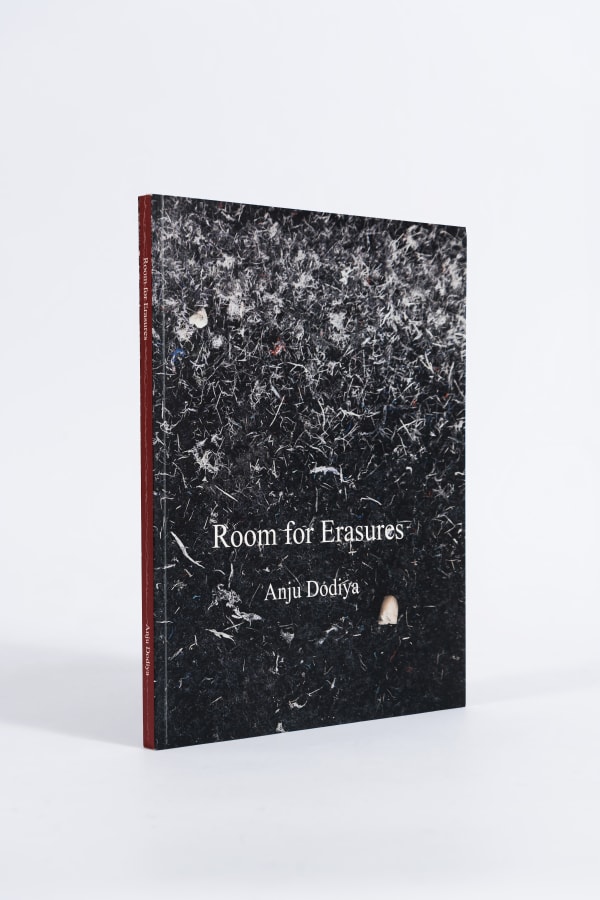
Room for Erasures
Anju Dodiya 2012SoftcoverRead more
Dimensions: 28 x 21.5 cm
-

India Art Fair 2025 | Chemould Prescott Road
New Delhi 6 - 9 Feb 2025Public days: Feb 6 - 9, 2025 We look forward to welcoming you once again in person to our booth at India Art Fair 2025....Read more -
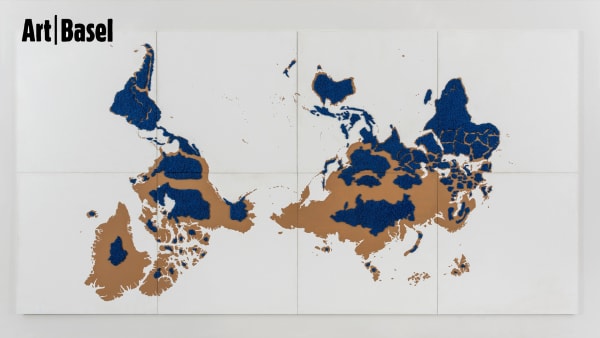
Art Basel 2024
Basel, Switzerland 12 - 16 Jun 2024Booth L6 We look forward to welcoming you once again in person to our booth at Art Basel 2024. This year we present works by...Read more -
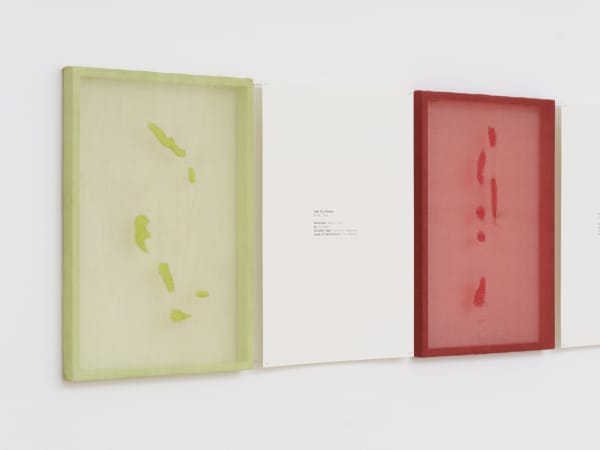
Art Dubai
Dubai 1 - 3 Mar 2024Booth E2 Public days: Mar 1 - 3, 2024 We look forward to welcoming you once again in person to our booth at Art Dubai...Read more -

India Art Fair 2024
New Delhi 1 - 4 Feb 2024Booth B2 Public days: Feb 1 - 4, 2024 We look forward to welcoming you once again in person to our booth at India Art...Read more -

Art Mumbai
Mumbai 16 - 19 Nov 2023Read more -

Art Basel 2023
Basel, Switzerland 15 Jun - 18 Dec 2023Booth J9 We look forward to welcoming you once again in person to our booth at Art Basel 2023. Highlights will include works by Anju...Read more -
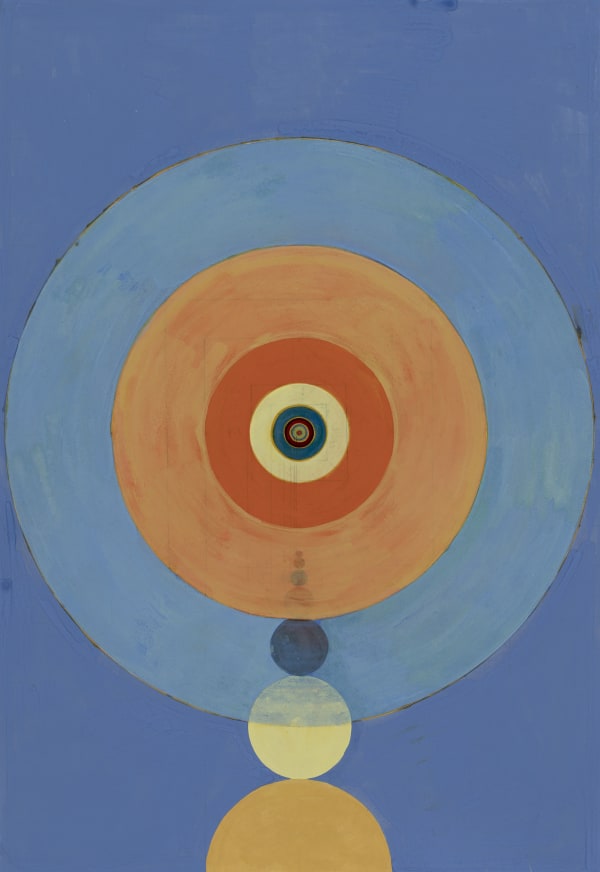
Art Dubai
Dubai 1 - 5 Mar 2023Booth E1 Public days: Mar 1 - 5, 2023 We look forward to welcoming you once again in person to our booth at Art Dubai...Read more -
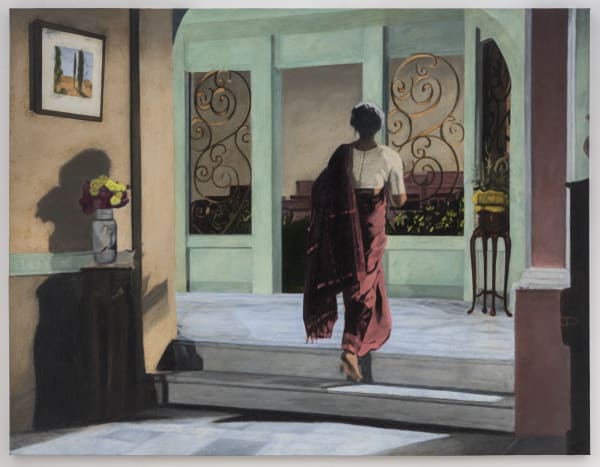
India Art Fair 2023
New Delhi 9 - 12 Feb 2023Booth B2 Public days: Feb 9 - 12, 2023 We look forward to welcoming you once again in person to our booth at India Art...Read more -
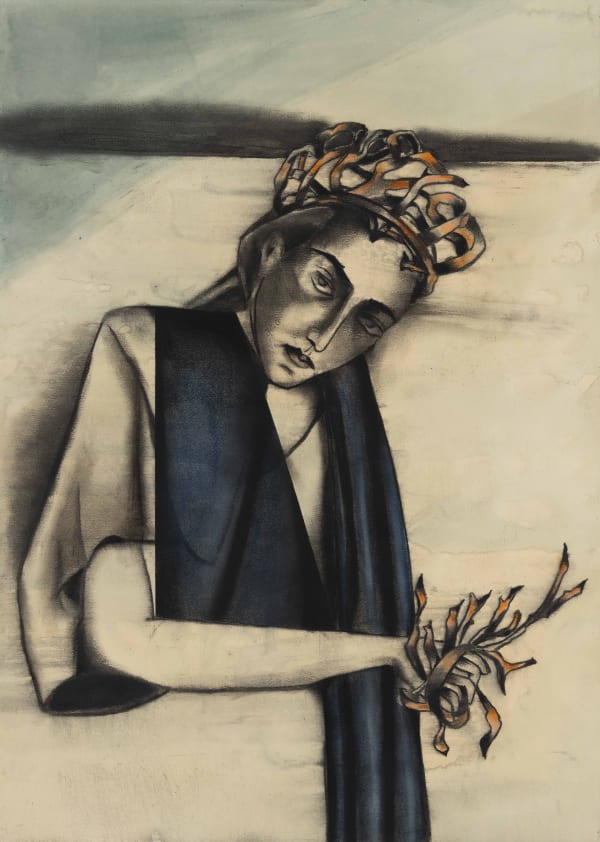
India Art Fair 2022
New Delhi 28 Apr - 1 May 2022This year we look forward to returning to India Art Fair; presenting new works across multiple mediums created by nine of the gallery artists. Anju...Read more -

Art Basel 2021
Basel, Switzerland 20 - 26 Sep 2021Public days: Sep 20 - 26, 2021 We look forward to welcoming you once again in person to our booth at Art Basel 2021. Highlights...Read more -
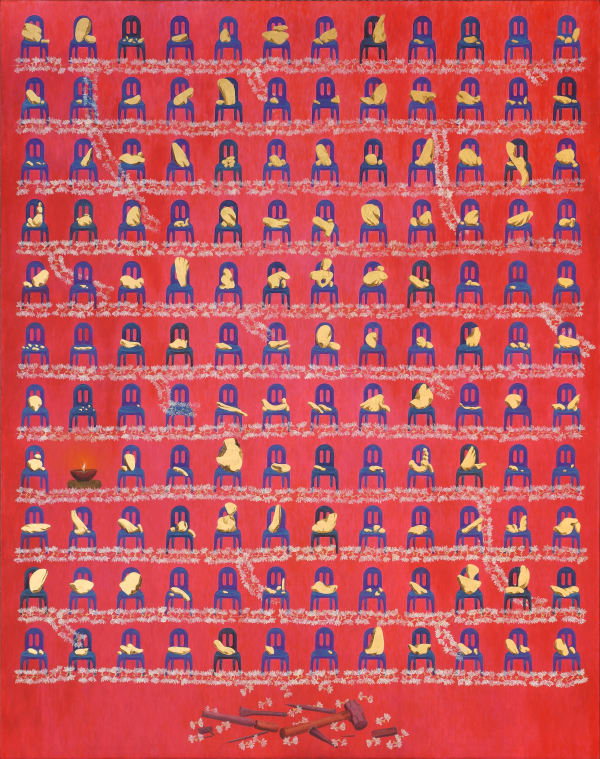
Art Basel 2020
Online 17 - 26 Jun 2020Online Viewing Room Public days: June 19 - 26, 2020 VIP Preview: June 17 - 19, 2020 To access the Online Viewing Rooms, create an...Read more -

Art Basel Hong Kong 2020
Online 18 - 25 Mar 2020Online Viewing Room Public days: March 18 - 25, 2020 To access the Online Viewing Rooms, create an Art Basel Profile here Chemould Prescott Road...Read more -
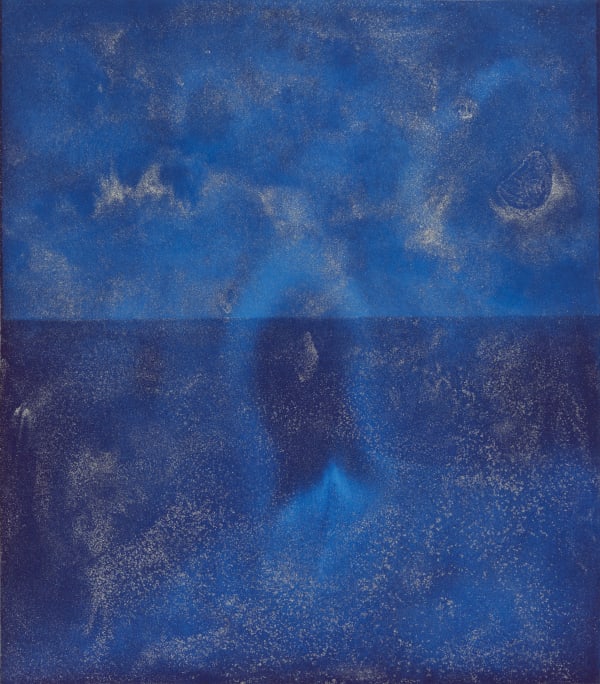
India Art Fair 2020
New Delhi 30 Jan - 2 Feb 2020Public days: Jan 30 - Feb 2, 2020 Chemould Prescott Road presents a suite of works this year at India Art Fair 2020 that reflect...Read more -
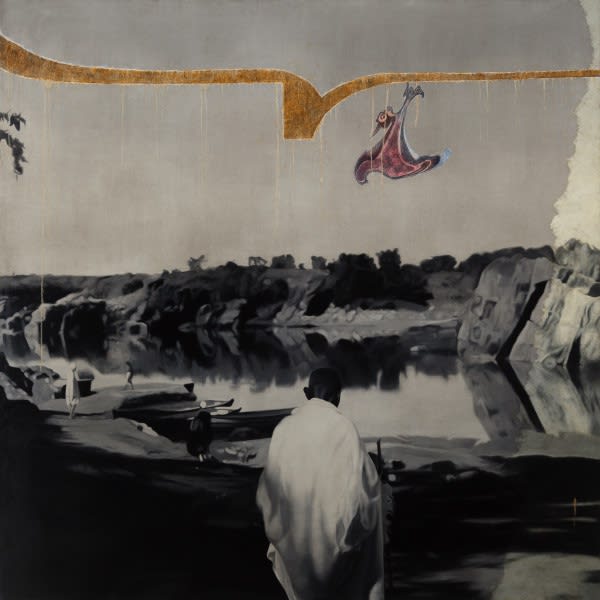
Art Basel 2019
Basel, Switzerland 12 - 16 Jun 2019Public days: June 12 - 16, 2019 Chemould Prescott Road has a roster of senior, mid-career and young artists who have been part of the...Read more -

Art Basel Hong Kong 2019
Hong Kong 29 - 31 Mar 2019Public days: March 29 - 31, 2019 Chemould Prescott Road has a roster of senior, mid-career and young artists who have been part of the...Read more -

India Art Fair 2019
New Delhi 31 Jan - 3 Feb 2019Public days: Jan 31 - Feb 3, 2019 Chemould Prescott Road presents a suite of works this year at India Art Fair 2019 that reflect...Read more -

Art Basel 2018
Basel, Switzerland 13 - 17 Jun 2018Chemould Prescott Road presents a suite of works this year at Art Basel that reflect the diverse sensibilities of its gallery programme. From Anju Dodiya...Read more -
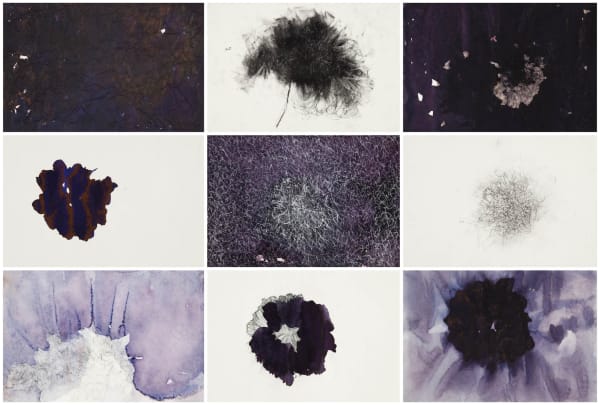
Art Basel Hong Kong 2013
Hong Kong 23 - 26 May 2013Public days: March 15 - 17, 2015 Chemould Prescott Road has a roster of senior, mid-career and young artists who have been part of the...Read more -
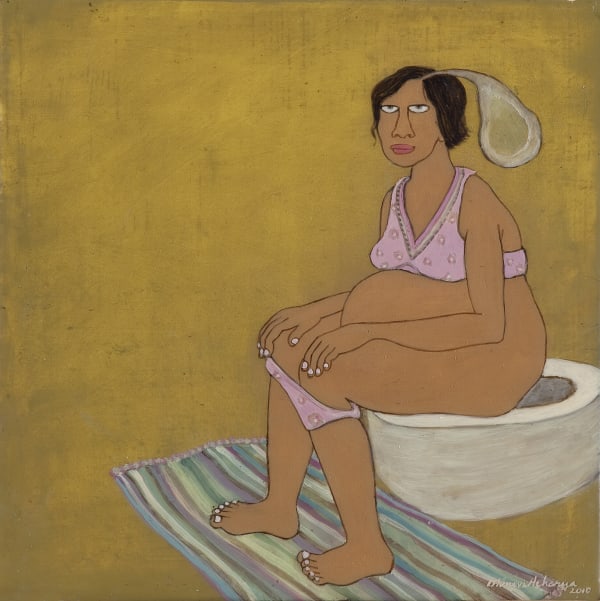
FIAC 2011
Paris, France 20 - 23 Oct 2011Public days: Oct 20 - 23, 2011 Chemould is honored to return to the Grand Palais in Paris for the 2011 Edition of Foire Internationale...Read more


